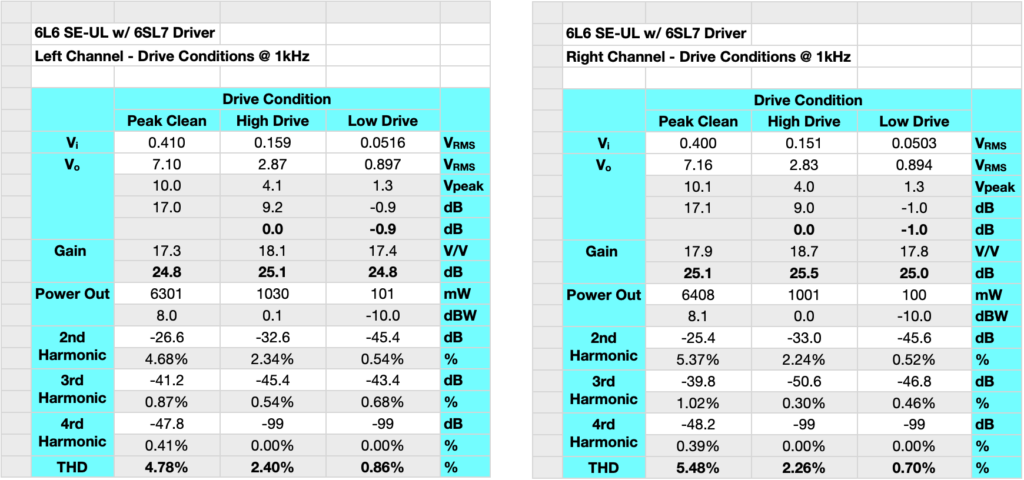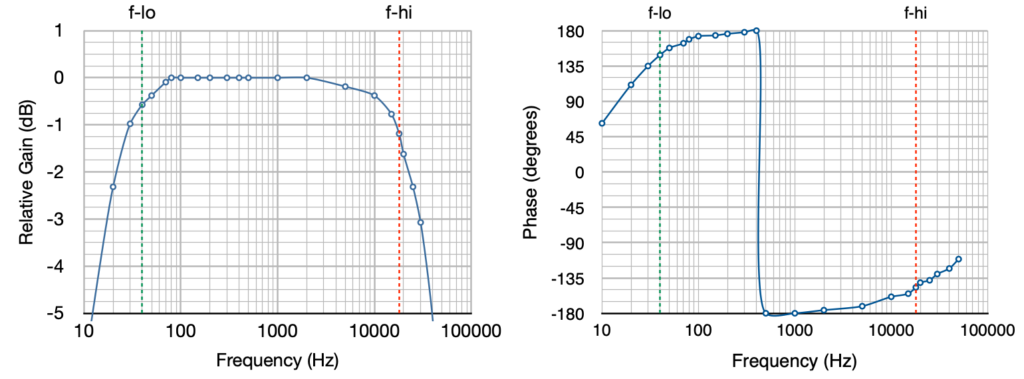I spent some time this afternoon taking technical performance data on the new amp. Unsurprisingly, the technical data is in agreement with my impressions from the excellent listening session yesterday. This amp is a solid performer and just what I wanted from the design.
For starters, here is the summary performance data for both channels taken at midband.
This data shows the performance data for both channels at three different drive conditions. The first of these I call “Peak Clean”. This is determined from simply watching the output waveform on the oscilloscope and increasing the drive until I can just see some flattening of the output sine wave. The other two drive conditions are the required drive for output powers of 1W and 100mW.
As can be seen the amp peaks out at around 8dBw or 6.3 watts per channel. It can obviously go higher than this but this is where the harmonics really start to grow. At 1 watt the amp is nice and clean with around 2.4% THD which is virtually all second harmonic. At 100mW the THD is well below 1% which is imperceptible under real world listening conditions.
This is also a very sensitive amplifier requiring only about 400mv rms to achieve full power. For those requiring less sensitivity the 6SL7 driver can be replaced with a 6SN7 driver. I’ll provide data for the alternate driver at some point in the future.
For those that are curious, here are the bandwidth gain and phase plots for the amplifier.
The 3dB bandwidth goes from ≈18Hz to ≈30kHz and the 1dB bandwidth goes from ≈30Hz to ≈17kHz. The low end rolloff at 20Hz is -2.3dB and the high end rolloff at 20kHz is -1.6dB. This is excellent performance for a SE-UL amplifier.
I am glad that I went with the 15W Edcor output transformers. One problem with UL amplifiers is the rather large effective plate resistance of the power tubes in this topology which can limit low end performance. The larger primary inductance of the 15W output transformers helped to compensate for this and resulted in a very pleasant and well behaved low frequency response.
The tubes are running very close to the design point. Here are the bias conditions for the signal and power tubes.
Plate voltages for the power tubes are within 5v of the 350V target and the cathode bias voltages are just about 1.5v below the 32v target. This is to be expected with the slightly lower B+ of ≈386v at the power stages. The plate dissipation on the 6L6s is still too high for the older style 6L6 and 6L6G tubes, but is well below the limits for the 6L6GC and 5881 tubes. I don’t have a pair of KT88s to try it out yet, but when I do, I’ll post the performance with those as well.
The complete writeup for this amp should be available on the web page in a week or two.
As always, questions and comments are more than welcome.




Bravo Matt.
The full report will be interesting.
I await the KT88 data.
I will be most curious how they perform as well.